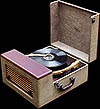| General Electric JM-3 1942 |
| This is a super-streamlined 78-rpm record player, made for the 1942 model year—a model year that was cut short by the United States' entry into World War II and the conversion of consumer manufacturing facilities over to military use. The player was to be plugged into the phonograph input of a radio so equipped. It has no active electronics—only a crystal pickup, volume control, and motor. |  |
| Silvertone 9073B 1950 |
 | This is a radio/record-player combination unit. The radio uses the common All American Five circuit, and the phono pickup is connected into the audio amplifier section. |
| Voice of Music 985 1952 |
| Oooh, this one sure is ugly, isn't it? But it uses one of those wonderful V-M "tri-o-matic" record changers that I grew up with, so I couldn't resist when I saw it available for sale. Thus are junk collections made. |  |
|
|
| Voice of Music 920 ca. 1953 |
| I grew up with another copy of this same V-M model. When I was still just a toddler, my parents began to let me play records on it. It was kept in the bottom (so I could reach) drawer of a cabinet in my parents' kitchen, and it played through our Firestone S-7426-1, which was specially modified with a phono input jack. My parents later told me that I got a head start on learning to read by reading the labels on their 78-rpm record collection as I picked the ones I wanted to hear. |  |
| Zenith H664 1951 |
| Oh boy . . . attach drool cups! The entire humongous cabinet of this radio/phono combo, including the ginormous lid, is molded from Bakelite. It has a large eight-inch speaker, and an advanced single-knob tone control (in the center of the radio dial pointer) that removes treble tones when turned counterclockwise and removes bass tones when turned clockwise. It's almost as good as having separate bass and treble controls. The overall result is a very good sounding radio, much better than I expected from an All American Five circuit. |  |
|




